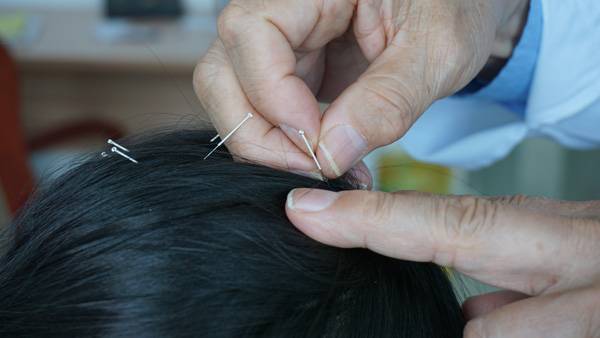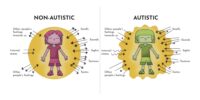Scalp Acupuncture Vs. Body Acupuncture: Targeted Approaches For Healing And Pain Relief

Acupuncture is a traditional Chinese medicine technique that has been used for centuries to treat various health conditions. It involves the insertion of thin needles into specific points on the body to stimulate the body’s natural healing response.
While body acupuncture is the most well-known and widely practiced form of acupuncture, scalp acupuncture is a targeted approach that focuses on the scalp and has gained popularity in recent years. This article aims to explore the differences between scalp acupuncture and body acupuncture, including their techniques and benefits.
Additionally, it will discuss the conditions that can be treated with each approach and the potential benefits of combining the two techniques for maximum healing. Finding an experienced acupuncturist is crucial to ensure the effectiveness and safety of these targeted acupuncture approaches.
Lastly, other targeted acupuncture techniques will be briefly explored.
Understanding the Basics of Body Acupuncture
Body acupuncture is a traditional Chinese medicine technique that involves the insertion of thin needles into specific points on the body to promote healing and relieve pain.
This practice is based on the concept of Qi, the vital energy that flows through the body along meridians or pathways. According to traditional Chinese medicine, illness and pain occur when the flow of Qi is disrupted.
By stimulating specific acupuncture points, the acupuncturist aims to restore the balance of Qi and promote the body’s natural healing processes.
The effectiveness of body acupuncture has been supported by various studies, showing its potential to alleviate pain, reduce inflammation, and improve overall well-being.
It is often used as a complementary therapy for a wide range of conditions, including chronic pain, migraines, digestive disorders, and stress-related conditions.
Exploring the Benefits of Scalp Acupuncture
This discussion will focus on the benefits of scalp acupuncture, specifically in targeting specific points on the scalp and its potential in treating neurological and psychological conditions.
Scalp acupuncture involves the insertion of thin needles into specific points on the scalp, which are believed to correspond to different areas of the body.
This targeted approach allows for precise stimulation of the nervous system, potentially aiding in the treatment of conditions such as stroke, multiple sclerosis, and depression.
Targeting Specific Points on the Scalp
Targeting specific points on the scalp offers a focused approach for healing and pain relief through scalp acupuncture. This technique involves stimulating specific areas on the scalp using fine needles, which are believed to activate corresponding regions of the brain and nervous system. Each point on the scalp is believed to have unique therapeutic properties and can be targeted to address specific health concerns. By strategically selecting and stimulating these points, scalp acupuncture aims to achieve targeted effects on the body’s overall well-being.
To further illustrate the specificity of scalp acupuncture, the following table provides an overview of some commonly targeted scalp points and their associated therapeutic benefits:
| Scalp Point | Therapeutic Benefits |
|---|---|
| Baihui | Enhances mental clarity and cognitive function |
| Shenting | Alleviates headaches and migraines |
| Sishencong | Reduces stress and anxiety |
| Fengchi | Relieves neck and shoulder pain |
| Touwei | Improves vision and eye health |
Through the targeted approach of scalp acupuncture, practitioners aim to address specific health concerns by stimulating the corresponding points on the scalp, leading to healing and pain relief.
Treating Neurological and Psychological Conditions
Treating neurological and psychological conditions involves the application of scalp acupuncture to stimulate specific points on the scalp. This is believed to activate corresponding regions of the brain and nervous system, resulting in therapeutic effects on mental health.
Scalp acupuncture has been found to be particularly effective in the treatment of conditions such as stroke, multiple sclerosis, Parkinson’s disease, and post-traumatic stress disorder. The stimulation of specific scalp points has been shown to promote blood circulation, increase oxygen supply to the brain, and stimulate the release of neurotransmitters. These effects can help alleviate symptoms and improve overall brain function.
Additionally, scalp acupuncture has been found to have a positive impact on psychological conditions such as anxiety, depression, and insomnia. By targeting specific points on the scalp, scalp acupuncture offers a targeted and focused approach to healing and pain relief for individuals with neurological and psychological conditions.
Comparing the Techniques: Scalp vs. Body Acupuncture
Comparatively analyzing the techniques of scalp acupuncture and body acupuncture provides a comprehensive understanding of their distinctive approaches in promoting healing and pain relief.
Scalp acupuncture involves the insertion of needles into specific points on the scalp, targeting the cerebral cortex. This technique is particularly effective for treating neurological conditions such as stroke, multiple sclerosis, and Parkinson’s disease. It stimulates the brain’s motor and sensory functions, facilitating the recovery of damaged neural pathways.
On the other hand, body acupuncture focuses on the meridian system, which consists of energy pathways throughout the body. By inserting needles into specific points along these meridians, body acupuncture aims to restore the balance of qi, or life force energy, and alleviate pain and illness.
In comparing these techniques, it is important to consider the emotional impact they can have on patients. Scalp acupuncture, with its direct targeting of the brain, may evoke feelings of hope and optimism for those suffering from neurological conditions. Body acupuncture, with its focus on overall balance and energy flow, may provide a sense of relaxation and well-being.
Ultimately, the choice between scalp and body acupuncture depends on the individual’s specific condition and desired outcomes.
Conditions Treated with Body Acupuncture
Body acupuncture is widely used to address a variety of medical conditions and promote overall well-being. This technique involves the insertion of thin needles into specific points on the body to stimulate and balance the flow of energy, known as Qi.
Body acupuncture can be effective in treating musculoskeletal conditions such as arthritis, back pain, and sports injuries. It is also used to alleviate symptoms of digestive disorders, respiratory conditions, and neurological disorders. Additionally, body acupuncture has shown promising results in managing mental health conditions such as anxiety, depression, and insomnia.
Research studies have demonstrated the effectiveness of body acupuncture in pain relief, immune system enhancement, and stress reduction.
Overall, body acupuncture is a versatile and holistic treatment approach that offers a wide range of benefits for various medical conditions.
Conditions Treated with Scalp Acupuncture
One effective method for addressing a range of medical conditions involves the application of acupuncture techniques specifically targeting the scalp. Scalp acupuncture, a specialized form of acupuncture, involves the insertion of thin needles into specific points on the scalp in order to stimulate the central nervous system and promote healing. This technique has been used for centuries in traditional Chinese medicine and is believed to be particularly effective for conditions such as stroke rehabilitation, neurological disorders, and pain management.
Scalp acupuncture works by stimulating the specific scalp points associated with different areas of the body. This targeted approach allows for the precise treatment of various conditions. Additionally, scalp acupuncture can be used in combination with body acupuncture to enhance the overall therapeutic effect.
The use of scalp acupuncture has shown promising results in clinical trials, with patients experiencing improved motor function, reduced pain, and enhanced overall well-being. Overall, scalp acupuncture offers a targeted and effective approach for the treatment of a wide range of medical conditions.
Combining Scalp and Body Acupuncture for Maximum Healing
By combining scalp and body acupuncture techniques, practitioners can optimize the healing potential of acupuncture therapy for a wide range of medical conditions.
Scalp acupuncture focuses on stimulating specific points on the scalp to treat various conditions, including neurological disorders, pain management, and psychological issues.
Body acupuncture, on the other hand, involves inserting needles into specific points on the body to regulate the flow of Qi and restore balance.
When these two techniques are combined, they create a synergistic effect that enhances the therapeutic outcomes.
The scalp acupuncture targets the central nervous system directly, while body acupuncture promotes overall physical and mental well-being.
This approach allows for a more targeted and comprehensive treatment plan, addressing both the local and systemic aspects of the condition.
By combining scalp and body acupuncture, practitioners can provide maximum healing potential to their patients.
Finding an Experienced Acupuncturist
When seeking an experienced acupuncturist, it is important to consider their credentials and training. A highly trained acupuncturist will have completed a rigorous educational program and obtained proper licensing and certification.
Additionally, it is beneficial to review patient reviews and recommendations to gain insight into the acupuncturist’s skills and effectiveness in treating various conditions.
Credentials and Training
Credentials and training in scalp acupuncture and body acupuncture are essential for practitioners to effectively apply targeted approaches for healing and pain relief. Acupuncturists who specialize in scalp acupuncture should have received extensive training in this specific technique. This includes acquiring a thorough understanding of the anatomical structures and meridians of the scalp, as well as the precise locations of the acupuncture points.
Additionally, they should possess knowledge of the underlying principles and theories of scalp acupuncture, including its unique diagnostic methods and treatment strategies. Similarly, acupuncturists practicing body acupuncture should have comprehensive training in this modality. This includes a deep understanding of the human anatomy, meridian systems, and acupuncture point locations on the body.
Adequate training and credentials ensure that practitioners are equipped with the necessary knowledge and skills to provide effective treatment and pain relief through scalp acupuncture or body acupuncture.
Patient Reviews and Recommendations
Scalp acupuncture and body acupuncture are both targeted approaches for healing and pain relief, but they differ in their techniques and effectiveness. In the previous subtopic, we discussed the credentials and training required for practicing these acupuncture methods.
Now, let’s shift our focus to patient reviews and recommendations. Hearing from patients who have undergone these treatments can provide valuable insights into their experiences and outcomes. By analyzing patient reviews, we can gain a better understanding of the effectiveness of scalp acupuncture and body acupuncture in treating various conditions. This information can help prospective patients make informed decisions about which approach may be best suited for their specific needs.
To help you navigate this topic, here are four key points to consider when evaluating patient reviews and recommendations:
- Treatment outcomes
- Pain relief effectiveness
- Duration of treatment
- Overall satisfaction
By paying attention to these aspects, patients can make well-informed decisions about their acupuncture treatment options.
Exploring Other Targeted Acupuncture Approaches
This paragraph discusses other targeted acupuncture approaches.
These approaches include ear acupuncture (auriculotherapy) and hand and foot acupuncture.
These approaches focus on specific areas of the body to stimulate healing and pain relief.
Auriculotherapy involves the stimulation of specific points on the ear, while hand and foot acupuncture target points on the hands and feet respectively.
Ear Acupuncture (Auriculotherapy)
Ear acupuncture, also known as auriculotherapy, is a targeted approach that can provide healing and pain relief. It involves stimulating specific points on the ear that correspond to different parts of the body. The concept behind auriculotherapy is based on the idea that the ear is a microsystem of the whole body, and by stimulating these points, it is possible to influence the corresponding body parts and promote healing.
One way to illustrate the concept of auriculotherapy is through a table that shows the different ear points and their corresponding body parts. Below is an example of such a table:
| Ear Point | Corresponding Body Part |
|---|---|
| Shen Men | Brain, nervous system |
| Kidney | Kidneys, urinary system |
| Lung | Lungs, respiratory system |
| Liver | Liver, digestive system |
| Heart | Heart, circulatory system |
This table highlights the specific points on the ear that can be targeted during auriculotherapy sessions, and the corresponding body parts that may benefit from the stimulation. It demonstrates the targeted nature of this approach and its potential for providing healing and pain relief.
Hand and Foot Acupuncture
Hand and foot acupuncture is a therapeutic modality that involves stimulating specific points on the hands and feet, which correspond to different areas of the body, in order to promote balance and well-being.
This approach is based on the principle that the hands and feet are microcosms of the entire body, and by targeting these areas, one can affect the corresponding organs or systems.
The specific points on the hands and feet are identified based on traditional Chinese medicine meridian theory, which maps out the pathways of energy flow in the body. Acupuncture needles or other techniques, such as acupressure or laser therapy, can be used to stimulate these points.
Hand and foot acupuncture is commonly used to treat a variety of conditions, including pain, digestive disorders, and stress-related ailments. It is a non-invasive and cost-effective treatment option that can be easily incorporated into a holistic approach to healthcare.
Frequently Asked Questions
What are the potential side effects or risks associated with scalp acupuncture?
Potential side effects or risks associated with scalp acupuncture include pain, bleeding, infection, dizziness, and fainting. However, these adverse effects are generally rare and mild, and can be minimized by seeking treatment from a qualified and experienced practitioner.
Can scalp acupuncture be used as a standalone treatment, or is it typically combined with body acupuncture?
Scalp acupuncture can be used as a standalone treatment or combined with body acupuncture. However, the decision depends on the specific condition and the preferences of the practitioner and patient.
Are there any specific conditions or symptoms that are better suited for body acupuncture compared to scalp acupuncture?
There are certain conditions or symptoms that may be better suited for body acupuncture compared to scalp acupuncture. Further research is needed to determine the effectiveness of each approach for specific ailments.
How long does it typically take to see results from scalp acupuncture treatment?
Results from scalp acupuncture treatment can typically be seen within a few sessions, with patients experiencing improvements in symptoms such as pain relief and enhanced motor function. However, individual response may vary depending on the specific condition being treated.
Are there any contraindications or precautions to consider before undergoing scalp acupuncture?
Contraindications and precautions should be considered before undergoing scalp acupuncture. It is important to assess the patient’s medical history, as certain conditions such as bleeding disorders, infections, or skin conditions may limit the use of this treatment.








